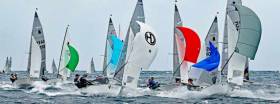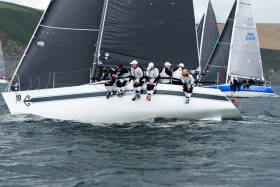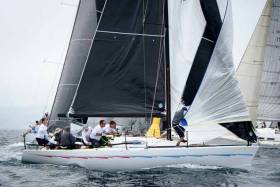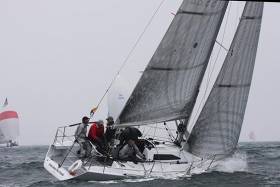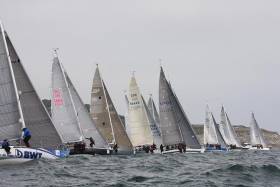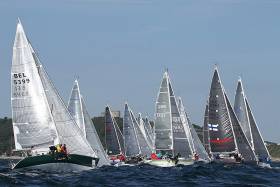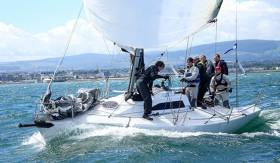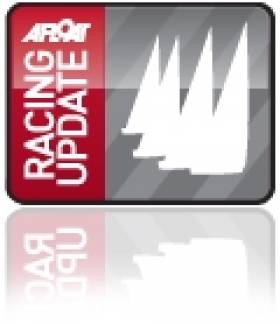Displaying items by tag: Half Ton Cup
The date for the Half Ton Classic Cup 2022 announced this week for Cowes following the cancellation of the 2021 event due to COVID-19 has changed its dates.
Inbox
The Cup will now be run from the 15-19th August 2022 to avoid an overlap with Cork Week 300.
Resilient Irish Sailing Scene Moves on From This Week’s Setbacks
With 178 Optimists racing in the Irish Nationals at Kinsale, and Ireland’s GP14 dinghies in fine form after the massive Worlds in England as they gather for their own Nationals in Sligo this weekend through to Monday, there’s much to be hopeful about even as our cruiser-racers deal with the fallout from the multi-gale depredations on the programme in the ICRA Nationals at Galway, and the damage-forced retirement from the Round Britain & Ireland Race of Conor Fogerty and Simon Knowles in Bam! W M Nixon hopes to brighten the mood.
The remains of Subtropical Storm Ernesto could not have chosen a more inconvenient time to swing by the west coast of Ireland and the Outer Hebrides of Scotland than during this past week.
For meteorologists, one of the curiosities was that Ernesto was so all-encompassing that he included in his swirling airmass not only an enormous long plume of smoke from the wildfires in California, but dust from the Sahara. That’s globalisation, and no mistake.
Subtropical Storm Ernesto
And he also brought us in Ireland far more than our fair share of extremely humid and unstable air, lots of it moving at near gale force, with all of it very dense to exacerbate the effects of wind speed. With its added ingredients of smoke and dust, it was not only humid – it was arguably putrid.
 Somewhere, the sun is shining……this was the Optimist Junior Fleet in action off Kinsale on Thursday. Photo: Robert Bateman
Somewhere, the sun is shining……this was the Optimist Junior Fleet in action off Kinsale on Thursday. Photo: Robert Bateman
Seen from a lee shore, the Ernesto Effect produced unspeakable sea and sailing conditions which made race cancellations in Galway Bay inevitable. And for those already out at sea and racing in the RB & I marathon, the endlessly varying wind strengths and its many weaving directions led to widespread damage in the Sevenstar fleet, and several retirals to ports along Ireland’s Atlantic seaboard.
Up to a point, we could take it all in our stride. But when Bam!’s dejected crew were forced to pull out on Thursday morning, it was time and more to look elsewhere for signs of encouragement in the Irish sailing scene, news and stories to remind us that, until a week ago, the season of 2018 was going very well indeed, and it will soon be back on track again.
178 Optimists at the Nationals in Kinsale
So that figure of 178 Optimists at the Nationals in Kinsale is hugely encouraging, particularly when we remember that the Irish Optimist racing scene is so highly regarded internationally that teams from six other nations have come to Kinsale to race as Open division entries.
Because it’s children’s sport, some limits apply in reporting Optimist success. But when new stars such as Justin Lucas of Clonakilty and more recently Rocco Wright of Howth emerge with brilliant performances, the news gets out.
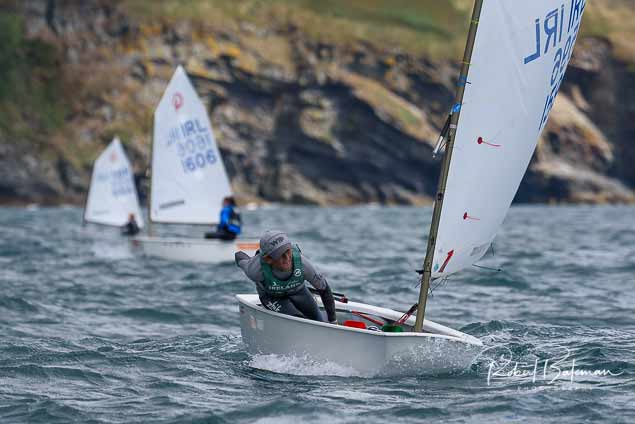 Rising star. Justin Lucas of Royal Cork & Tralee is one of Irish sailing’s most successful youth helms
Rising star. Justin Lucas of Royal Cork & Tralee is one of Irish sailing’s most successful youth helms
And living as I do in an Optimist neighbourhood (half the houses in our road seem to have evidence of at least one Optimist dinghy in the family), part of the fascination of Optimist campaigning is its entertainment value for the rest of us. When you see an entire family (including the pooch) heading off for a championship with the total package of support RIB, several Optimists attached here, there and everywhere - with the roof-rack of the SUV also utilized – then you’re really looking at something special, yet we take it for granted.
It’s very much a combined effort, and that is something which we see manifested in other successful classes such as the close-knit Flying Fifteens in Dun Laoghaire, and the GP 14s nationwide.
GP14 Worlds 2020 at Skerries
In an era when novelty and innovation seem to be the priorities that we seek in vehicles and equipment, the GP 14 is a real curiosity. She goes all the way back to 1949 – yes, she’ll be 70 next year – and her original purpose was that, as a hard-chined boat built in marine plywood, she could be home-built by any reasonably competent Do-It-Yourself enthusiast at a time when DIY was widely popular.
She was called the GP as it meant General Purpose and most assuredly not Grand Prix, with day cruising or even longer non-racing ventures considered an option. But soon, the new boat had acquired a spinnaker, and racing was on the agenda and moving rapidly towards the top. It has stayed there ever since as the GP 14’s main purpose in life.
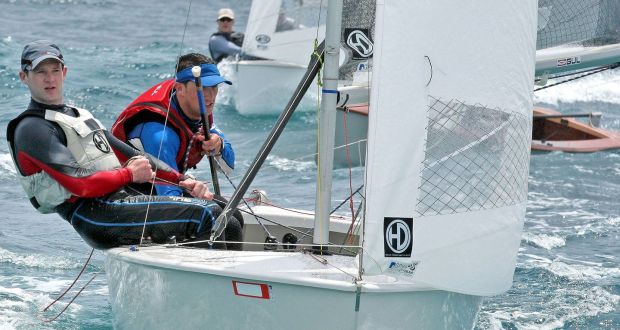 Andy Davis (left) and Greystone SC’s Shane MacCarthy on their way to winning the GP 14 Worlds 2016
Andy Davis (left) and Greystone SC’s Shane MacCarthy on their way to winning the GP 14 Worlds 2016
Many new dinghy designs have appeared since 1949 to promote fresh classes, yet the GP 14 continues to trundle successfully along – more than 14,000 have been built worldwide. And though glassfibre construction has been used in some cases – Shane MacCarthy of Greystones won the GP 14 Worlds in 2016 in Barbados in a GRP GP14 – wood construction continues to be much favoured, and one of the very best builders in the world is Alistair Duffin of East Belfast, who succeeded his father Gerry in the business of creating exquisite wooden boats which are also race-winners.
 The unmistakable look of a Duffin GP14 hull – this one won the Worlds in 2012
The unmistakable look of a Duffin GP14 hull – this one won the Worlds in 2012
His boat-building skills are such that other classes try to avail of his services when there’s the tiniest gap in his GP 14 orderbook – at the moment he’s putting a new deck on a Dublin Bay Mermaid, evidence of another of Ireland’s much-loved older classes finding itself with a new lease of life.
One aspect of such classes is that they give you the feeling of being in one great big family, and certainly in the GP14s in particular, the family thread runs strong, with parents as readily crewing for children as the other way round.
The class is renowned for its provision of good value for its members. This was particularly apparent when the GP 14 Worlds of 2014 was held at East Down Yacht Club on Strangford Lough. The renowned Norman Lee of Greystones was among those taking part with his impressive compact largely self-created equipage of campervan-cum-workshop with boat and gear and spares, all of it on site and typical of a class where a monumental yet quietly effective community effort was needed each day to get the fleet – almost exactly a hundred in all – neatly away for each day’s racing.
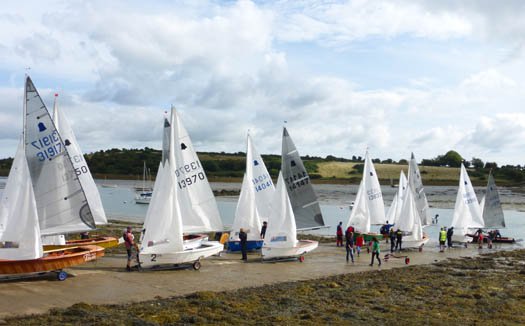 Fleets at most of the biennial GP 14 Worlds are so large that a convenient beach can be very useful, but in 2014 at East Down YC on Strangford Lough, they had to rely on a well-organised routine down a long slipway. Photo: W M Nixon
Fleets at most of the biennial GP 14 Worlds are so large that a convenient beach can be very useful, but in 2014 at East Down YC on Strangford Lough, they had to rely on a well-organised routine down a long slipway. Photo: W M Nixon
This sense of readily-supported group effort within GP 14 Ireland reached a new level in 2016, when the Worlds were set for Barbados in March. The prospect of Caribbean sailing at the tail end of the Irish winter was a mighty attraction, but the logistics of it would have been beyond most classes. Yet the unrivalled community spirit within the Irish GPs saw 22 boats being taken Transatlantic in a well co-ordinated container movement combined with an affordable travel and accommodation package which was negotiated though sensible group action, and planning well ahead.
The fact that in some magnificent racing the new GP 14 World Champion was to emerge as Shane MacCarthy of Greystones, crewed by Andy Davis, was the perfect finishing touch to a great adventure, and a timely reminder that the Irish GP 14 class has had its World Champions in the past, with Bill Whisker and Jimmy McKee of Ballyholme winning in 1975, while Mark and Paul Fekkes from Larne won in 1991.
Thus the main international focus for the Irish class this season has been the recent GP 14 Worlds in southwest England at Mounts Bay in Cornwall, where a convenient gently sloping beach provides the exceptional launching facilities required by a fleet of 117 boats, for which 17 travelled from various Irish centres, while total Irish participation was pushed above the 20 mark with our GP 14 sailors who currently live in Britain.
 The distinctive shape of St Michael’s Mount dominates the race area during the recent GP14 Worlds at Mounts Bay in Cornwall. Irish helms took second and fourth in the 117-strong fleet.
The distinctive shape of St Michael’s Mount dominates the race area during the recent GP14 Worlds at Mounts Bay in Cornwall. Irish helms took second and fourth in the 117-strong fleet.
Inevitably, defending champion Shane MacCarthy was something of a marked man, and going into the final race he seemed assured of the bronze. But he was pushed into fourth, and the best of the Irish was Ross Kearney with the Silver, sailing under the burgee of the Royal North of Ireland YC at Cultra, and crewed by Ed Bradburn of South Staffs SC.
After Shane MacCarthy in fourth, next best of the Irish was Ger Owens of Royal St George YC at 9th. He is one of those leading Irish dinghy sailors who is equally renowned for his successes in other boats, most of them of more modern type, yet he reckons that for sport and value, keeping a GP 14 in trim and having someone as able as regular crew Melanie Morris to campaign with makes it well worth the effort.
In a fleet of this size, everyone will have found their level where the sport is at its best, and age is no barrier. We wouldn’t dream of even guessing at the age of Curly Morris of Larne, but he has been sailing GP 14s for as long as we’ve known him, which is very far back into the previous millennium. Yet there he was at Mounts Bay, merrily sailing around with all his replacement joints in reasonable working order, and taking 19th overall with Laura McFarland of Newtownards SC as his crew.
 Supersenior Sailor – veteran Curly Morris is as keen as ever. Photo: Robert Bateman
Supersenior Sailor – veteran Curly Morris is as keen as ever. Photo: Robert Bateman
As for top all-women crew, that went to Katy Dwyer and Michelle Rowley of Sutton Dinghy Club, who were comfortably into the top half at 41st, which gave them a solid fifth in the Silver Fleet.
With full-on across-the-board participation by the Irish entries as events concluded at Mounts Bay in the first week of August, there’s been little enough time to re-charge batteries before this weekend’s Sligo gathering. But with GP 14 Ireland in the build-up to another big one on the home front within two years, the momentum is on, with the count-down already under way towards the GP 14 Worlds 2020 at Skerries, where this year in July they’ve already staged the Leinsters, won by Shane MacCarthy with Ger Owens second and Alan Blay and David Johnston of Sutton third.
This will put a double-focus on MacCarthy at Sligo, as he’s defending National Champion, having won at Ballyholme last year. So all that’s needed in Sligo is a relenting of the weather to set the stage for the sort of racing the GP 14s relish.
It speaks volumes of a class in good heart, and with GP14 Ireland now having David Cooke of Skerries as President, there’s a strong home team in place to provide a World Championship worthy of the competitors, while on the boat front, the word is that Alistair Duffin’s order book for new GP 14s is well-filled to 2020.
World Sailing Championships on the Fingal Coast
It all means that 2020 is going to be quite a year for World Championships on the Fingal coast, as fourteen miles to the south at Howth, one of HYC’s main events for 2020 will be staging the Fireball Worlds.
 The National YC’s John Lavery on the helm and David O’Brien on the wire, on their way to winning the Fireball Worlds 1995 in Dublin Bay. The Fireball Worlds 2020 will be staged at Howth. Photo: Shane O’Neill
The National YC’s John Lavery on the helm and David O’Brien on the wire, on their way to winning the Fireball Worlds 1995 in Dublin Bay. The Fireball Worlds 2020 will be staged at Howth. Photo: Shane O’Neill
While the Fireball Class doesn’t have the same national coverage in Ireland as the GP 14, it continues to be a significant international force, and of course Irish faith in the Fireball is still sustained by memories of the World Championship in Dublin Bay in 1995, won by John Lavery and David O’Brien of the National Yacht Club.
The very idea that the coast of Fingal would be hosting two world championships at two different venues within the county in 2020 would have been seen as far-fetched back in 1995. But population growth has seen club development across the board in the north county – think, for instance, of the remarkable growth of Rush Sailing Club’s success – and the area’s lack of commercial shipping is a real boon when Dublin Port’s increasing activity keeps the Bay’s shipping lanes busier than ever.
Then, too, when the Atlantic weather is excessively flexing its muscles, the well-islanded coast of Fingal’s great sailing water has all of Ireland to provide a lee when the big westerlies roar across country to make racing events impossible on open water on the Atlantic seaboard.
Half Ton Classics Worlds at Nieuwpoort
So between Optimists and GP 14s and Fireballs, there is much to cheer us in the current and future scene. And as for cruiser racing, there may have been a glitch, but in the Irish Sea ISORA soldiers on, and we’ve two Howth boats – Dave Cullen’s Checkmate XV and Jonny Swann’s Harmony – in with a shout in next week’s Half Ton Classics Worlds at Nieuwpoort in Belgium. Life goes on.
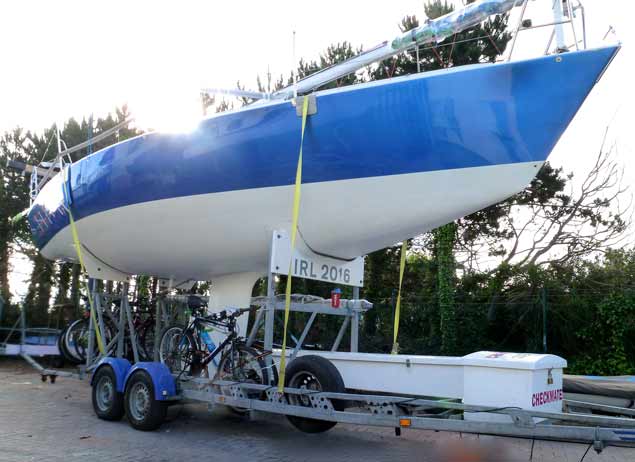 All packed up, and ready to go….Dave Cullen’s classic Half Tonner Checkmate XV road-ready at Howth for departure to Nieuwpport in Belgium and the Half Ton Classic Worlds which start on Monday. Photo: W M Nixon
All packed up, and ready to go….Dave Cullen’s classic Half Tonner Checkmate XV road-ready at Howth for departure to Nieuwpport in Belgium and the Half Ton Classic Worlds which start on Monday. Photo: W M Nixon
 No, you weren’t seeing things – Checkmate XV travels with five crew bicycles, as getting around some yacht harbours takes longer than you think, and the exercise is good for them. Photo: W M Nixon
No, you weren’t seeing things – Checkmate XV travels with five crew bicycles, as getting around some yacht harbours takes longer than you think, and the exercise is good for them. Photo: W M Nixon
 Jonny Swann’s Harmony, overall winner of the all-comers Harbour Race in Volvo Cork Week, will also be representing Howth in the Half Ton Championship in Belgium. Photo: Robert Bateman
Jonny Swann’s Harmony, overall winner of the all-comers Harbour Race in Volvo Cork Week, will also be representing Howth in the Half Ton Championship in Belgium. Photo: Robert Bateman
Reviewing Half–Ton Sailing: The Classic Cup in Kinsale & a Sailors Poll to Decide the Future
Mark Mansfield, tactician on The Big Picture, fourth overall at August's Euro Car Parks Half Ton Classic Cup 2017, reviews progress in the Class and the Kinsale Yacht Club event.
Having done the last two versions of this event I feel I have a decent level of knowledge to comment on the racing and the classes progression. Firstly well done to the organisers for staging a great event at Kinsale Yacht Club and well done to the Principal Race Officer Anthony O'Leary for running it so well. Finally, well done to Phil Plumtree and the Swuzzlebubble team for winning the regatta with a race to spare. This is the third win for Swuzzlebubble in three events, each with a different owner. More about this later.
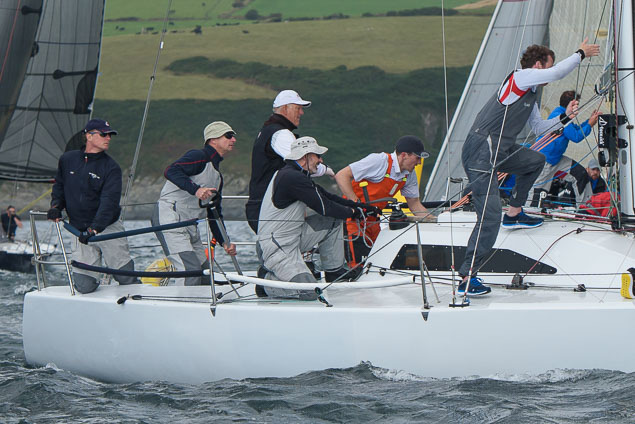 Mike and Richie Evans's The Big Picture, from Howth Yacht Club was fourth overall. Tactician and article author Mark Mansfield is wearing the white cap Photo: Bob Bateman
Mike and Richie Evans's The Big Picture, from Howth Yacht Club was fourth overall. Tactician and article author Mark Mansfield is wearing the white cap Photo: Bob Bateman
Day One—Nigel Biggs' new Checkmate XV111 just led from Paul Pullen's Miss Whiplash on countback. Swuzzlebubble lay one point back and Mike and Richie Evans,The Big Picture, lay a further point behind. David Cullen's Checkmate XV was a few points further back and it seemed likely that these five boats would be the feature boats in the event. All had professional sailors aboard and one of these boats had three professional sailors. Swuzzlebubble had an eighth place on this day which she would eventually discard but it was clear that she would be the one to watch as she was the top rating boat by some margin and was using that extra speed to get out in front allowing her to sail her own race.
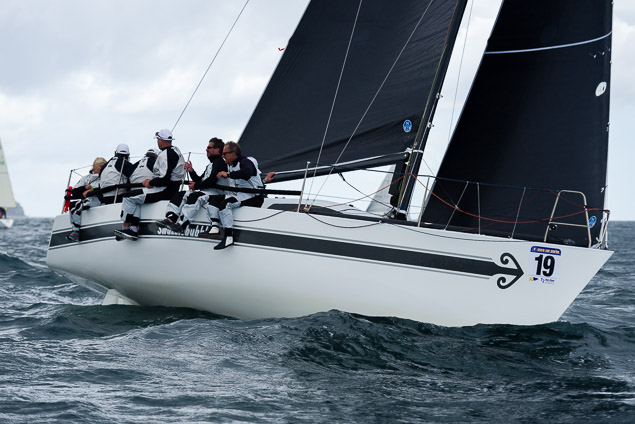 Phil Plumtree's Swuzzlebubble had an eighth place on day one but it was clear that she would be the one to watch as she was the top rating boat by some margin Photo: Bob Bateman
Phil Plumtree's Swuzzlebubble had an eighth place on day one but it was clear that she would be the one to watch as she was the top rating boat by some margin Photo: Bob Bateman
Day Two—Strong Southerly winds were forecasted for the following few days and so the organisers took the decision to delay the coastal race until later in the week and use day two to get in as many short WL races as possible. In the end four good races were sailed in moderate to fresh testing conditions. Swuzzlebubble counted two wins and two second places to shoot into a large lead over David Cullen's Checkmate who also scored two firsts. One point back was Checkmate XVIII and The Big Picture lay in fourth, a few points back. Big loser of the Day was Paul Pullen's Miss Whiplash who had four very average results and fell out of the running. It was now clear that the first four boats (Swuzzlebubble, Checkmate XV, Checkmate XVIII and the Big Picture) were pulling well clear of the pack and the winner would be from this group. Occasionally, other boats such as Paul Wayte's beautiful newly optimised Headhunter, Johnny Swan's Harmony and Philippe Pilatte's General Tapioca would come to the fore, but it was the first four that generally filled the top three results in each race and were pulling well clear.
 Paul Pullen's Miss Whiplash had four very average results on day two and fell out of the running Photo: Bob Bateman
Paul Pullen's Miss Whiplash had four very average results on day two and fell out of the running Photo: Bob Bateman
Day Three—Wednesday was postponed due to excess wind and many enjoyed a long lunch in Kinsale's Fishy Fishy restaurant accompanied by some very nice wines.
Day Four—Strong Southerly winds greeted the competitors and three races were planned including the none–discard coastal race. Swuzzlebubble took a first and a second in the earlier Windward Leeward races to extend her lead and the two closest followers, the two Checkmates each counted a poorish race to allow Swuzzlebubble be on the cusp of winning the regatta outright if she had a decent last coastal race. The Big Picture had consistent top results to lie in fourth. The final race of the day, the coastal race, ended in Swuzzlebubble taking a fifth, though a relatively poor result for her, it was enough to ensure Swuzzlebubble could not now be caught and did not need to sail the final race on the Friday. 1.5 points now separated the Two Checkmates with Dave Cullen in the marginal lead. Big Picture finished the Coastal race in second place and lay in fourth overall and could neither fall to fifth in the last race on Friday, nor get up to third. There was then a large points gap to General Tapioca and Headhunter.
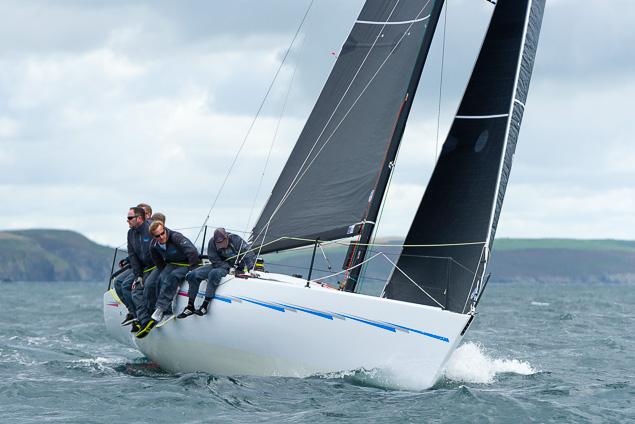 Only 1.5 points separated the two Checkmates with Dave Cullen's Checkmate XV (below) in the marginal lead. Photos Bob Bateman
Only 1.5 points separated the two Checkmates with Dave Cullen's Checkmate XV (below) in the marginal lead. Photos Bob Bateman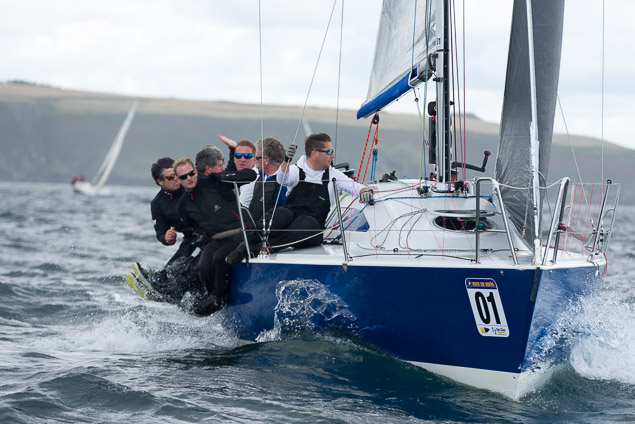
A successful Class dinner was held in Actons Hotel on Thursday night which went on late into the night, for some.
Day Five—Swuzzlebubble decided not to sail on the Friday. First and fourth places were already finalised (Swuzzlebubble and The Big Picture). Nigel Biggs needed to finish ahead of Dave Cullen and have a boat between them to finish in second overall. 17 to 20 knots greeted the fleet and PRO O'Leary signalled an around the buoys race consisting of two rounds and a finish off Charles Fort in Kinsale. Nigel Biggs got the best of the start and was ahead most of the race. However, Dave Cullen was in a bunch close behind that included the Big Picture. By the last mark Nigel Biggs rounded in the lead, followed by three other boats flowed by Big Picture with Checkmate XV behind her. Big Picture pulled through to second and Checkmate XV to third across the line. Big Picture with her lower handicap had a chance to snatch the win and deny Checkmate XVIII second overall but fell short by nine seconds and so the race finished with Checkmate XVIII winning followed by The Big Picture, followed by Checkmate XV, thus giving second overall to Nigel Biggs and Third overall to David Cullen. Fourth overall went to the Big Picture, fifth to General Tapioca and sixth to Miss Whiplash.
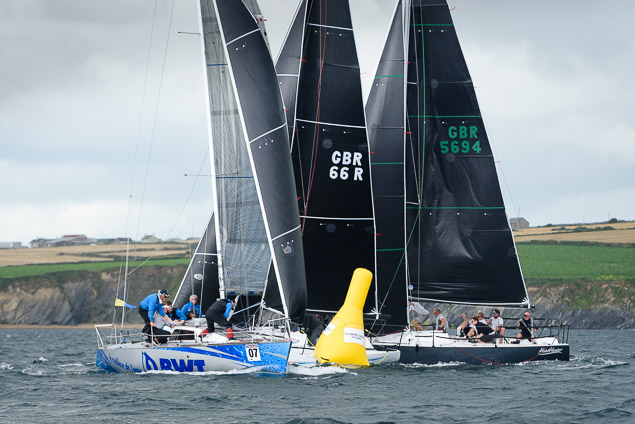 Half Ton racing is excellent, very close. The camaraderie within the class is also very strong
Half Ton racing is excellent, very close. The camaraderie within the class is also very strong
Progression of the class – Three newly optimised boats were among the 21 entries this year. The larger fleets of Half–Tonners are based in France, the UK and Belgium and if the event were in one of these locations it is likely entries would be closer to 30. During the regatta an agm was held to discuss some important points that appear to be affecting the class. These were;
1 Should the class limit the number of professionals on each boat
2 Should the class, like they do in the Quarter ton Class, put an upper handicap limit on yachts taking part.
3 Should the class allow asymmetrical spinnakers.
1—Limiting professionals. A poll of Half Ton members will likely be done to either limit the professionals on each boat to either one or Two. It was felt generally that professionals help to coach the crew and generally are good for the class, but too many and the professionals can effectively sail the boat themselves, thus little improvement happens when the pros depart.
2—Limiting the upper Handicap limit. Swuzzlebubble has been a problem child in this class since Peter Morton did a no–expenses spared restoration of this very long half tonner. This included a taller, ultra high Modulus Carbon Rig with more sail, a deeper keel and other top mods. This led to her being approx. 25–points higher rating than most. Consequently she can go for a conservative start, sail for a few minutes and then her speed allows her to cross the fleet and sail the remainder of the race without other interference. The remainder of the fleet are close on rating and end up very close to each other at all marks, taking wind on downwinds, etc. This is costing the bulk of the fleet a minute or more per race, and often that is about the margin that Swuzzlebubble wins by. She is being well sailed, but she has a great advantage. In the Quarter ton class they stopped this issue early and now most quarter tonners are within 10 points of rating of each other. It is being suggested that an upper limit of .965 be introduced. Swuzzlebubble would be able to get to this by reducing sail area and adding some weight which would lessen the advantage she currently enjoys, especially in light to medium conditions. A proposed poll of the class is being organised on this.
3—Allowing Asymmetric sails. This appeared not to be so straight forward. Some owners already have them (but can't use them at the Half Ton Cup). Allowing them might mean owners have to buy one or two asymmetric kites, perhaps add a sprit and in the end may not even use them at a Half Ton cup. Others would prefer to stay without them as most of the racing is windward leeward anyway. This will also be balloted.
Summary – Having sailed four Quarter Ton Cups and now two Half Ton cups, The Half Ton class is now easily as competitive as the quarter tonners. The racing is excellent, very close. The camaraderie within the class is very strong. I can see more restorations being done in this class and numbers rising for their Half Ton Cups. Next years event will be in Nieuwpoort in Belgium in mid–August and I suspect that there may be up to 30–boats will arrive for that. The inaugural IRC World Championships is being held just up the road in The Hague in Holland a month before the Half Ton worlds so there are many half–tonners considering doing that as well as a warm up event. The boats are of a size that they can, if required, be transported by water, though most will trail behind jeeps.
Mark Mansfield is a four–time Irish Olympian, a helmsman in the Star Class from 1992–2004. He is a World Sailing 'Group 3' Sailor.
Finland's Broken Mast No Problem for Half Tonners in Kinsale, Classic Cup Starts Today
As the 21-strong fleet (just two down from expectations in March) for the Euro Car Parks Half Ton Classics Cup at Kinsale Yacht Club prepares for race one this morning, a race against time has been ongoing since Friday to ensure one boat would make the start.
Finland’s Toni Stoschek and Janne Tulokas were en route to Ireland with Superhero earlier in the week when an articulated lorry accidentally reversed into their mast while queuing for the ferry crossing.
The badly bent spar was beyond salvage or repair and for a time it seemed the journey to Ireland would be wasted.
However, the class rallied and the hunt began for a replacement. In a major logistical operation, a spare mast was loaned by King One and transported by Nigel Biggs of Checkmate XVIII by road across the UK and travelled by ferry to Rosslare where it was collected by Paul Cullen of Miss Whiplash, arriving in Kinsale on Saturday morning.
By Sunday’s practice race, Superhero was just able to make the starting-line after some rig tuning. “We hope that we can mix it up with the best despite our… slow start,” said Stoschek.
Conditions at Kinsale are expected to deliver a full range of wind for the coming five days, from light airs to near gale at times. Three windward-leeward races per day are planned while the coastal race intended for Tuesday may be amended to ensure a full race programme is completed.
Phil Plumtree’s Swuzzlebubble is the pre-regatta following on two previous title wins though three new boats and an increasingly competitive fleet could yet upset the running-order.
Ireland will be the base for the Nigel Biggs Checkmate XVIII Half Ton campagin this season with a programme that includes the ICRA Nationals, Sovereigns Cup, Dun Laoghaire Regatta and the Half Ton Cup in Kinsale.
In a previous Irish campaign, Biggs was the overall winner of the 2013 'Boat of the Week' at a massive Dun Laoghaire Regatta edition with seven straight wins in class two.
Biggs's 'new' Half–Tonner that is currently very much a work in progress (see photo above) is the old Emiliano Zapata, ex Dick Dastardly, ex French Beret, ex Concorde from 1985. As with his previous two successful half–tonners (Harmony and Checkmate XV) she has been 'breathed on' by Wicklow yacht designer Mark Mills with a revised sailplan and keel. All the work is being undertaken at his team base near Bangor in North Wales and he anticipates launching early May.
Having campaigned his C&C 30 in the US in the US last year, (debuting in Dun Laoghaire in 2015) Biggs say his 12–year–old daughter had been nagging him to get a boat over this side of the Atlantic so she could sail with him more often. 'What father could refuse such a request?' he told Afloat.ie
Checkmate XVIII boat will be sailed by his usual team, some of whom have sailed together for over 20 years and some of whom have only joined over the last couple of years ( Dun Laoghaire's Adam Hyland and Cian Guilfoyle) plus his daughter, of course.
Irish Boats Perform Well At Half Ton Classics Cup
Day three of the Henri Lloyd Half Ton Classics Cup was sponsored by Sta-Lok and brought a change of weather and a change of overall leader. After two days of glorious sunshine the sailors found themselves sailing in the infamous Cornish mizzle (a cross between mist and drizzle) with a south easterly breeze of around 10 to 12 knots. The swell had subsided a little, but was most definitely still in evidence and the lighter breeze made it even harder to navigate through.
The Flushing Sailing Club Race Committee started the day with a pair of windward leeward races and then set the third course around permanently laid marks in Falmouth Bay with the finish off Port Pendennis. As the event reached the midway point the racing was closer than ever with some new faces coming to the top of the heap and mere seconds separating the leading boats on corrected times.
Mike Evans' The Big Picture, whose crew includes Irish Olympian Mark Mansfield and top International Dragon crew Adam Winkelmann, really found their form and were top performing boat of the day with a 1, 3, 2 scoreline. They won the opener by two seconds from Paul Pullen's Miss Whiplash with Greg Peck's Swuzzlebubble third and Jonny Swan's Harmony fourth. Only 46 seconds separated the top six boats on corrected time with Jean-Philippe Cau and Claude Charbonnier's Sibelius fourth and Francis Marshall's Concorde fifth.
The second windward leeward race was also incredibly tight. Swuzzlebubble beat Sibelius by just one second with The Big Picture third, David Cullen's Checkmate fourth and Concorde fifth.
Race six brought plenty of drama with a huge right-hander on the first beat which caught out Swuzzlebubble and several other leading boats, a hook around the second mark that forced the rounding boats straight back into those still beating in, and Harmony making an enthusiastic port tack mark approach with a stack of boats inside her which created a mini drama all of its own. Fortunately no Half Tonners were injured in the completion of this race in which defending champion Checkmate claimed her first race win of the series with The Big Picture second, Harmony third, Sibelius fourth and Miss Whiplash fifth.
With six races now completed the first of two discards comes into play and Swuzzlebubble bounces up the leader board into first place one and a half points ahead of Miss Whiplash. Holding onto third place with a ten point delta is Harmony while Sibelius moves up into fourth a further point and a half back. Fifth and sixth are separated by just half a point with Checkmate just ahead of The Big Picture.
With two more days of sailing, up to six more races to sail and a forecast offering everything from six the thirty-six knots between now and Friday afternoon the regatta remains wide open.
Full results here
#HalfTonCup - Day 2 of the Henri Lloyd Half Ton Classics Cup, sponsored by day sponsor Mylor Yacht Harbour, saw the fleet taking part in a 40-mile Coastal Race, which carried a points weighting of 1.5.
For the second day running the wind was from the east creating big swells and some exciting seat of the pants sailing.
Greg Peck's Swuzzlebubble loves nothing better than a good windy beat and the race committee gave them just that with a 10-mile headbanger first leg that tested everyone's metal.
Swuzzlebubble rounded the weather mark with a handsome lead, but on the run the wind dropped somewhat, compressing the fleet. Paul Pullen's Miss Whiplash took full advantage of the situation gaining considerable ground.
As the boats rounded the last mark Swuzzlebubble still had a big lead on the water, but on corrected time she and Miss Whiplash were now neck and neck.
The final leg in through the heads was a close reach in an awkward swell and as Swuzzlebubble crossed the finish just off Falmouth all heads turned to see how Miss Whiplash was doing.
The stopwatches were out and as Whiplash crossed the line it was confirmed that, after more than five hours racing, she had won by a mere six seconds. Third place went to Jonny Swan's Harmony with Philippe Pilate's General Tapioca fourth.
In the overall standings, Miss Whiplash has pulled into a narrow 1.5 point lead over Swuzzlebubble, while Harmony moves up into third, leapfrogging over General Tapioca with a half point advantage.
Whilst the majority enjoyed a good romp in lovely conditions, one boat that most definitely did not enjoy today was Robbie Tregear's beautiful Per Elisa.
On the spinnaker hoist their genoa sheet got caught in the spinnaker sheet, preventing them from releasing the sheet so that the boat broached out and laid flat. They picked themselves up and got going again but had to gybe to make Gull Rock.
Robbie Tregear takes up the story: "During the gybe it's all a matter of timing, and we were slightly out. We got our speed down the wave, but we hadn't completed the gybe by the time we hit the bottom when the boat stopped but the kite carried on along with the rig, which crumpled into about five pieces."
Fortunately the crew were able to clear away the damaged rig and make their way home without outside assistance, but it brought their championship to an untimely end.
Back ashore, the fleet were treated to beers on the dock by A2 Rigging followed by the daily prize giving in the Regatta Marquee which is located immediately opposite the National Maritime Museum Cornwall.
Today (Wednesday 17 August) the fleet returns to inshore racing with races four and five of the series planned. The forecast was for the wind to remain easterly and in the mid to high teens so there was every expectation of another great day's sailing.
The regatta continues until Friday 19 August.
Half Ton Classics Cup Leaders Are Neck & Neck in Falmouth
The Henri Lloyd Half Ton Classics Cup 2016 got off to a spectacular start at Falmouth with big waves, a steady breeze, hot sun and two terrific races. The day was sponsored by Euro Car Parks and RAM Gaskets, and as well as great racing the fleet also enjoyed some traditional post sailing Cornish hospitality as the participants came together for a Cornish Pastie supper and the daily prize giving set against a spectacular sun set at Flushing Sailing Club.
Race Officer Jack Penty and his team were able to complete both a practice race and the first two championship races of the series in an easterly wind of around 15 knots. The wind strength was rather less than might have been expected for the sea state of big rolling and occasionally breaking waves, so keeping the boats powered up through the swell but under control was the order of the day.
As always with the Half Ton Class, the racing was extremely close and first blood went to Paul Pullen's 1986 Andrieu designed Miss Whiplash with Greg Peck's newly acquired 1977 Farr designed Swuzzlebubble, winner of the 2014 Half Ton Classics Cup with previous owner Peter Morton, second and Philippe Pilate's General Tapioca, launched in 1978 to a Berrett design, third.
The tables were turned in race two as Swuzzlebubble took victory from Miss Whiplash with the French team of Jean-Philippe Lau and Claude Charbonnier sailing the 1980 Jubert designed Sibelius third.
In the overall standings the Falmouth based Swuzzlebubble and Miss Whiplash lead the fleet with both boats counting three points and Swuzzlebubble taking the overall lead only on count-back. General Tapioca added a fifth in race two to their second from the opener, giving them eight points and third overall.
With such a big sea running it was inevitable that someone would find themselves demonstrating why IOR boats had such a well deserved reputation for downwind instability. M & R Evans and their crew from Howth Yacht Club, Ireland aboard The Big Picture performed a spectacular pirouette and the crew found themselves making as one with the non-slip. Fortunately they were soon back on their feet and bowling along with big grins all over their faces.
Another Irish team, this time from Rush Sailing Club, encountered another somewhat unexpected and decidedly damp incident when their lifeline lashing broke just after the start of race one. Although several of the crew of M & R Evens' The Big Picture fell off the side of the boat they were all able to hang on and were rapidly dragged back aboard.
The Half Ton Classics Class has a hugely loyal and committed membership who lovingly maintain and race these historic little yachts. A fine example of commitment to the class is David Evans of the Stephen Jones designed Hustler SJ32 Hullabaloo XV. Not only does David maintain his boat in fantastic order, but he will go to great lengths to attend the Half Ton Classics Cup. This year he sailed the boat 380 miles single handed from Walton Backwaters in Essex, including taking on a force eight gale, to get to Falmouth. Now that's what we call dedication!
The second day of racing will feature a single Coastal Race starting at 10.30am, which will have a points weighting of 1.5. The forecast indicates more easterly winds of 10 to 15 knots and the course, which will take the boats up and down the Cornish coast within a 20 mile radius of the entrance to Falmouth Harbour, will be announced at the daily competitors' briefing at 08.30. The regatta continues until Friday 19 August.
For full results here
With the start of the Henri Lloyd Half Ton Classics Cup 2016 fast approaching on Monday 15 August the Half Ton Classics and the town of Falmouth are in the final stages of preparation for what promises to be a bumper edition of this delightful annual event. With at least 30 teams expected to travel to Falmouth from across the UK, Ireland and Europe, competition will be fierce as these historic little ships do battle against the spectacular backdrop of the Cornish coastline.
Among those already entered is Ireland's David Cullen, who won the 2015 Half Ton Classics Cup and will be back to defend his title in his 1985 Humphreys MG HS30 Checkmate XV. Originally named Blue Chip, the boat was purchased by Nigel Biggs in 2012 who put the boat through a major refit with Corby Yachts. David purchased her from Nigel over the winter of 2014/15 and she once again went into Corby Yachts, this time to have a new cockpit and transom fitted. At the time his 2015 victory David noted "It's a very tricky boat. The new boats are very powerful and we're still trying to figure it out. But we've learnt a lot this week and we look forward to moving forward and maybe being a little bit faster for Falmouth next year." With another year of sailing the boat under their belts since then it will be interesting to see if they are that little bit faster.
Also making the trip from Ireland for the event are Jonny Swan with Harmony, which was built by Priors of Burnham in 1980 to a Rob Humphreys' design for Mike Holmes and Tony Allen (of Holt-Allen fame) and is widely regarded as one of the most successful Half Tonners ever built. Kelly Boardman from Howth is racing King 1, which was previously owned by Cullen and Michael and Richard Evans will be competing in their Humphreys MG30 Big Picture.
Belgium will be putting forward several strong teams led by Philippe Pilate's 1978 Berret designed General Tapioca which won the 2009 Half Ton Classics Cup in Nieuwpoort, but broke their mast during the 2015 event so will be hoping for better luck this year. Also coming from Belgium are Ian Van Burm's 1983 Humphreys one off Fantasy and Thibaut Martin's MG HS30 Spip.
Heading up the British contingent will be 2014 Half Ton Classics Cup winner Peter Morton's 1977 Bruce Farr designed Swuzzlebubble which will be helmed by Greg Peck. Peter Rutter has entered his recently purchased 1985 Andrieu designed Insatiable, which has been renamed Quokka 9. From the East Coast come Anthony Meehan and Jane Mardell's Lynx and David Evan's Hullabaloo XV.
There will also be a strong showing from the local Falmouth Half Ton fleet with entries from Paul Pullen's Miss Whiplash, Mel Sharp's Demolition, John Hicks' Rampage, Geoff Davies' Scorpion and Jonathan Cunliffe's legendary Emiliano Zapata.
As well as racing in the event Paul Pullen is also a key player on the oganising committee and is very much looking forward to welcoming such a strong fleet of half tonners to his home town. "We have been working and training very hard this year, we are really looking forward to sailing against all the top boats in our own back yard. We're lucky to have some of Europe's best sailing waters right on our doorstep and with the experience, enthusiasm and commitment of Flushing Sailing Club and our local team of volunteers and sponsors behind us it's going to be a fantastic event."
The Henri Lloyd Half Ton Classics Cup 2016 is being hosted by Flushing Sailing Club and registration for the regatta opens on Saturday 13 August and continues on Sunday 14 August. Monday will feature a practice race followed by windward leeward races. From Tuesday to Friday the fleet will sail a mixture of windward leeward, regatta and coastal courses. Inshore races will be run in Falmouth Bay or Carrick Roads and the coastal race will be run within a 10-mile radius of Black Rock Beacon.
The boats will be moored at Pendennis Marina with the Regatta marquee located on Falmouth's Event Square, adjacent to the National Maritime Museum of Cornwall. An extensive social programme for competitors and their friends and families will center around Flushing Sailing Club, the Regatta marquee and the Museum, which will host the Championship Dinner.
#halfton – The 2014 Half Ton Classics Cup came to a sparkling conclusion today with one final thrilling race off the beautiful North Brittany coast and a delightful prize giving on the waterfront of Saint-Quay-Portreiux writes Fiona Brown.
With the breeze a little lighter at around 10-14 knots we saw some different faces at the front of the pack today and the finish was incredibly close, both on the water and on corrected time. Robert Tregear's Per Elisa (1989 Ceccarelli), the last one off half tonner ever built, came into her own and gave Swuzzlebubble a run for her money, although they couldn't quite save their time and Swuzzlebubble won by 23 seconds. Third place went to Frederic Waniart's diminutive Maeva (1974 Mauric) who beat General Tapioca for third by a mere 0.16 seconds! Also much happier in today's lighter airs was Checkmate XV who took fifth, beating The Big Picture by 0.53 seconds!
Our winner, Peter Morton's Swuzzlebubble (1978 Farr), had already been confirmed yesterday, but still came out to race purely for the joy of it. And our remaining podium positions were confirmed as Bernard Fournier Le Ray's Brittany Drizzle (1978 Berret) evaded one final challenge from her sister ship General Tapioca, owned by Philippe Pilate, to claim second place with General Tapioca taking the third step on the podium.
At the prize giving each of the skippers was invited to the podium to receive an invitation to the 2015 Half Ton Classics Cup, which will be held in in Nieuwpoort, Belgium, from 17-23 August, and to say a few words about the regatta. They were universal in their praise of the Sport Nautique Saint-Quay-Portrieux for their organisation of the regatta, of the Half Ton Classics Class for their work behind the scenes, and of their crews and fellow competitors for the incredible competition, fun and camaraderie they have experienced this week.
Winner Peter Morton not only paid tribute to the organisers and his crew, but to his fellow owners and the incredible work they do in keeping these historic boats in such outstanding condition. He especially highlighted his closest challenger Bernard Fournier Le Ray, who he has known since Bernard built Indulgence, the boat in which Peter won the Three Quarter Ton Cup in 1986. Peter highlighted that Bernard built Brittany Drizzle himself in his garden in 1978 and has raced and maintained her personally ever since, giving Peter much good competition over the years. That she is in outstanding condition some 36 years later and still raced with great success at the highest level is a true testament to Bernard's skill as a builder and sailor and to the longevity of the Half Tonners. Peter concluded by saying he looked forward to racing with the fleet again at next year's event in Nieuwpoort.
Alongside the overall prizes there were a number of special presentations. David Evans' Hullabaloo XV, a 1978 Stephen Jones designed Hustler 32, won both the Production Boat Trophy and the Corinthian Trophy. A special presentation was made to Alexandre Neuilly and his crew of Turbidite (1983 Fauroux) who may have come last in the rankings this week, but who truly embody the spirit of fun, enthusiasm, determination, tenacity and humour that typifies the Half Ton Class.
And finally we came to the most important presentation of all, The Half Ton Spirit Trophy, which is awarded to the team, which, in the opinion of the Class and the Regatta Committee, truly embodies the extraordinary spirit of the class and the event. For their commitment and incredible personal hard work in keeping their beautiful boat in 100% as original condition, for sailing with great success with an entirely Corinthian crew and for racing her, runners, checkstays, titanium fittings and all, to an incredible ninth place overall, the 2014 Half Ton Spirit Trophy was awarded to deafening applause to Concorde (1989 Andrieu) owned by Francis Marshall and crewed by Robert Libby, Matt and Ivan Jacock, Peter Greenwood, Dick Jackman and Jack Spree - a bunch of Enterprise sailors and fishermen from Loo in Cornwall. A very moved Francis and his entire team came to the podium to accept the trophy and the recognition of their fellow sailors.
With the formalities complete a delighted but exhausted Philippe Pilate, President of the Half Ton Classics Class, summed up his feelings about the regatta; "The landscape, the weather and the technical aspects of the regatta were outstanding, but for me the quality of our welcome in Saint-Quay-Portrieux has been the highlight of the week. The members of Sport Nautique Saint-Quay-Portrieux and the people of the town have not only welcomed us as friends, but have made us feel like family. It has been quite extraordinary and we are sad to leave."
And so we say farewell to Saint-Quay-Portriuex and look forward to seeing the Half Ton Classics family once again in Nieuwpoort from 17-23 August 2015.


























